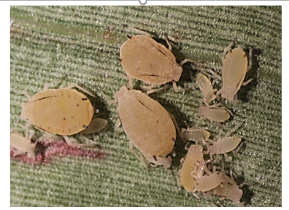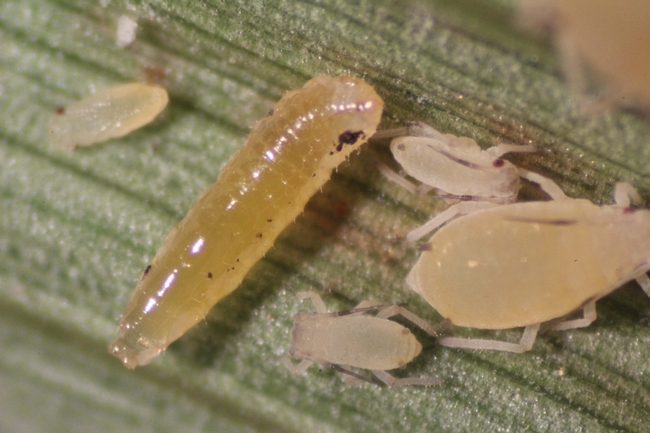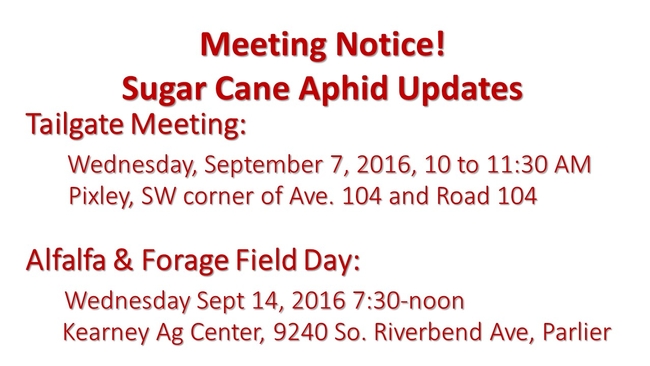
Sugarcane aphid can easily be distinguished from other aphid species due to their yellow color with black feet, tips of antennae and cornicles (tailpipes) that point upward from the rear of the insect. This is in contrast to greenbug and other aphid species in sorghum that have a greenish appearance. Host plants for sugarcane aphid include sugarcane, sorghum, sudangrass, sorghum X sudangrass hybrids, and the weed Johnsongrass (Sorghum halepense). It has not been found on corn.
Sugarcane aphids intercept nutrients intended for the development of leaves and grain heads by feeding on plant sap. Heavy infestations can kill leaves, stunt growth, and reduce the size and quality of grain heads. Honeydew and sooty mold on leaves can compromise photosynthesis and may also reduce harvest efficiency by gumming up harvest equipment.
Populations of sugarcane aphid can build very quickly. Informational resources from Texas A&M Extension report that in one location field populations went from 50 to 500 aphids per leaf over a two-week period. Adult aphids (all females) give live birth to nymphs that can develop into adults within about five days and that live for approximately four weeks during summer conditions. Aphids are usually wingless until population density is high, at which time some of the offspring begin to develop wings (alates) to disperse to new feeding locations.

Until more information is available for silage sorghum, California forage sorghum growers should do their best to adopt a modified version of the grain sorghum guidelines from other states. 1) Monitor at least weekly for sugarcane aphid. 2) Consider a tentative treatment threshold of 50 aphids per leaf if there is more than one month before harvest and a tentative treatment threshold of 150 aphids per leaf if there is less than 4 weeks before harvest. 3) Do not treat with chlorpyrifos or dimethoate. They have poor efficacy on sugarcane aphid and negatively affect natural enemies. If a treatment is needed, consider Sivanto 200SL or Sivanto Prime (PHI- 7 days for forage, 21 days for grain, stover or straw). Sivanto products are more expensive than traditional organophosphates, but can be effective and do not disrupt biological control. Applications can be made by ground or by air, though ground applications are likely to be more effective. 4) If heavy aphid populations are limited to field edges, consider destroying the infested edge, treating only the edges, or doing early harvest to field margins. If plants throughout the field are covered with honeydew and sooty mold, avoid insecticide treatments and consider early harvest.
Growers and researchers are currently watching sorghum fields to learn about how this pest is going to behave in California and determine how honeydew will impact harvest operations. Efforts are also underway to determine which insect predators naturally feed on sugarcane aphid, and to see if parasitoids of greenbug and other aphids may also attack this new species. The goal is to gather as much information as we can over the next couple of months to help us be better prepared for this pest during the 2017 production season.
